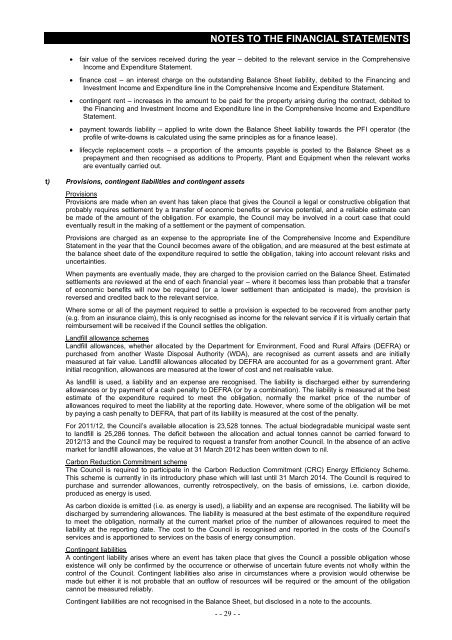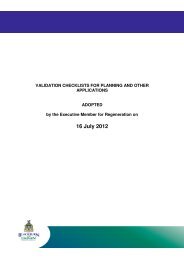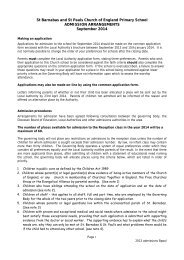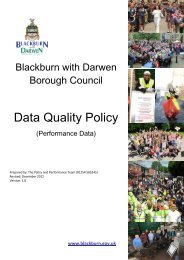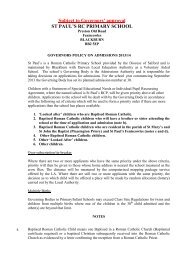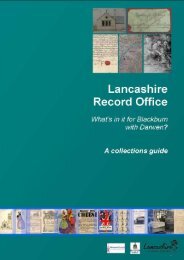Statement of Accounts 2011/2012 - Blackburn with Darwen Borough ...
Statement of Accounts 2011/2012 - Blackburn with Darwen Borough ...
Statement of Accounts 2011/2012 - Blackburn with Darwen Borough ...
Create successful ePaper yourself
Turn your PDF publications into a flip-book with our unique Google optimized e-Paper software.
NOTES TO THE FINANCIAL STATEMENTS<br />
• fair value <strong>of</strong> the services received during the year – debited to the relevant service in the Comprehensive<br />
Income and Expenditure <strong>Statement</strong>.<br />
• finance cost – an interest charge on the outstanding Balance Sheet liability, debited to the Financing and<br />
Investment Income and Expenditure line in the Comprehensive Income and Expenditure <strong>Statement</strong>.<br />
• contingent rent – increases in the amount to be paid for the property arising during the contract, debited to<br />
the Financing and Investment Income and Expenditure line in the Comprehensive Income and Expenditure<br />
<strong>Statement</strong>.<br />
• payment towards liability – applied to write down the Balance Sheet liability towards the PFI operator (the<br />
pr<strong>of</strong>ile <strong>of</strong> write-downs is calculated using the same principles as for a finance lease).<br />
• lifecycle replacement costs – a proportion <strong>of</strong> the amounts payable is posted to the Balance Sheet as a<br />
prepayment and then recognised as additions to Property, Plant and Equipment when the relevant works<br />
are eventually carried out.<br />
t) Provisions, contingent liabilities and contingent assets<br />
Provisions<br />
Provisions are made when an event has taken place that gives the Council a legal or constructive obligation that<br />
probably requires settlement by a transfer <strong>of</strong> economic benefits or service potential, and a reliable estimate can<br />
be made <strong>of</strong> the amount <strong>of</strong> the obligation. For example, the Council may be involved in a court case that could<br />
eventually result in the making <strong>of</strong> a settlement or the payment <strong>of</strong> compensation.<br />
Provisions are charged as an expense to the appropriate line <strong>of</strong> the Comprehensive Income and Expenditure<br />
<strong>Statement</strong> in the year that the Council becomes aware <strong>of</strong> the obligation, and are measured at the best estimate at<br />
the balance sheet date <strong>of</strong> the expenditure required to settle the obligation, taking into account relevant risks and<br />
uncertainties.<br />
When payments are eventually made, they are charged to the provision carried on the Balance Sheet. Estimated<br />
settlements are reviewed at the end <strong>of</strong> each financial year – where it becomes less than probable that a transfer<br />
<strong>of</strong> economic benefits will now be required (or a lower settlement than anticipated is made), the provision is<br />
reversed and credited back to the relevant service.<br />
Where some or all <strong>of</strong> the payment required to settle a provision is expected to be recovered from another party<br />
(e.g. from an insurance claim), this is only recognised as income for the relevant service if it is virtually certain that<br />
reimbursement will be received if the Council settles the obligation.<br />
Landfill allowance schemes<br />
Landfill allowances, whether allocated by the Department for Environment, Food and Rural Affairs (DEFRA) or<br />
purchased from another Waste Disposal Authority (WDA), are recognised as current assets and are initially<br />
measured at fair value. Landfill allowances allocated by DEFRA are accounted for as a government grant. After<br />
initial recognition, allowances are measured at the lower <strong>of</strong> cost and net realisable value.<br />
As landfill is used, a liability and an expense are recognised. The liability is discharged either by surrendering<br />
allowances or by payment <strong>of</strong> a cash penalty to DEFRA (or by a combination). The liability is measured at the best<br />
estimate <strong>of</strong> the expenditure required to meet the obligation, normally the market price <strong>of</strong> the number <strong>of</strong><br />
allowances required to meet the liability at the reporting date. However, where some <strong>of</strong> the obligation will be met<br />
by paying a cash penalty to DEFRA, that part <strong>of</strong> its liability is measured at the cost <strong>of</strong> the penalty.<br />
For <strong>2011</strong>/12, the Council’s available allocation is 23,528 tonnes. The actual biodegradable municipal waste sent<br />
to landfill is 25,286 tonnes. The deficit between the allocation and actual tonnes cannot be carried forward to<br />
<strong>2012</strong>/13 and the Council may be required to request a transfer from another Council. In the absence <strong>of</strong> an active<br />
market for landfill allowances, the value at 31 March <strong>2012</strong> has been written down to nil.<br />
Carbon Reduction Commitment scheme<br />
The Council is required to participate in the Carbon Reduction Commitment (CRC) Energy Efficiency Scheme.<br />
This scheme is currently in its introductory phase which will last until 31 March 2014. The Council is required to<br />
purchase and surrender allowances, currently retrospectively, on the basis <strong>of</strong> emissions, i.e. carbon dioxide,<br />
produced as energy is used.<br />
As carbon dioxide is emitted (i.e. as energy is used), a liability and an expense are recognised. The liability will be<br />
discharged by surrendering allowances. The liability is measured at the best estimate <strong>of</strong> the expenditure required<br />
to meet the obligation, normally at the current market price <strong>of</strong> the number <strong>of</strong> allowances required to meet the<br />
liability at the reporting date. The cost to the Council is recognised and reported in the costs <strong>of</strong> the Council’s<br />
services and is apportioned to services on the basis <strong>of</strong> energy consumption.<br />
Contingent liabilities<br />
A contingent liability arises where an event has taken place that gives the Council a possible obligation whose<br />
existence will only be confirmed by the occurrence or otherwise <strong>of</strong> uncertain future events not wholly <strong>with</strong>in the<br />
control <strong>of</strong> the Council. Contingent liabilities also arise in circumstances where a provision would otherwise be<br />
made but either it is not probable that an outflow <strong>of</strong> resources will be required or the amount <strong>of</strong> the obligation<br />
cannot be measured reliably.<br />
Contingent liabilities are not recognised in the Balance Sheet, but disclosed in a note to the accounts.<br />
- - 29 - -


